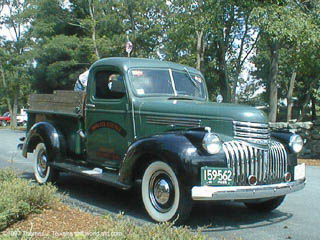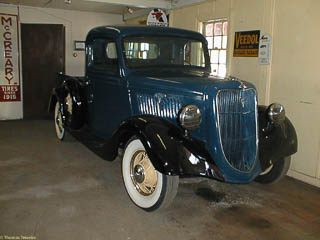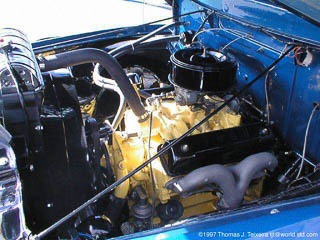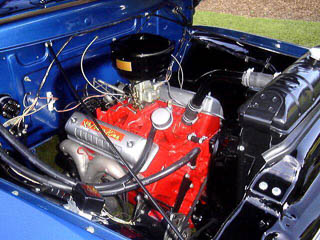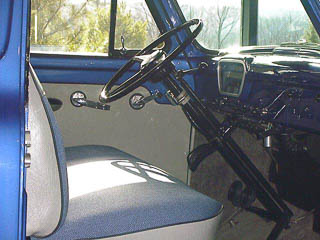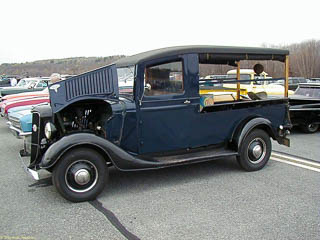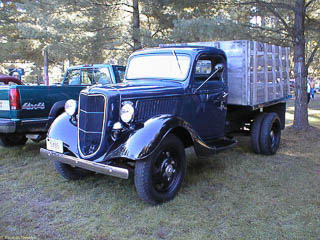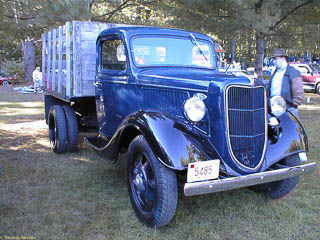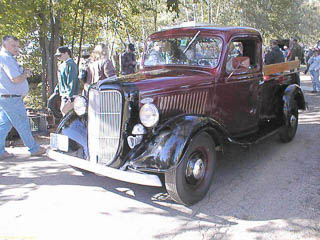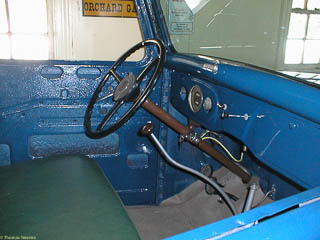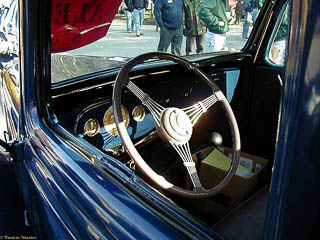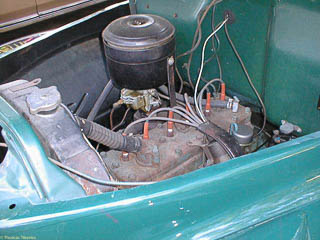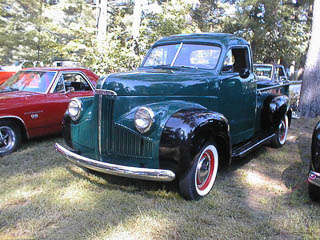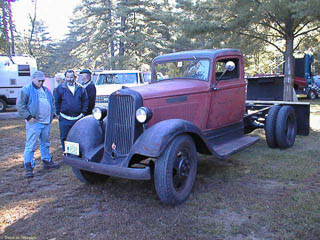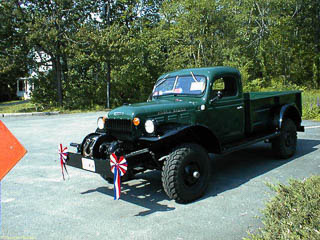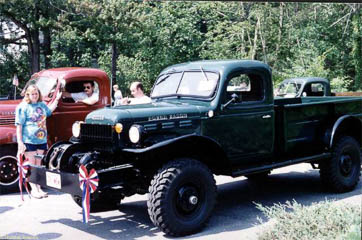1940-46 Chevy
This truck was entered in our town Fourth of July antique car (and truck) parade. What impressed us was a combination of how nice it looks and that it still does some work for a living, even if it may be more PR. I thought it
was a 1940 or so Dodge, but I've been informed it's a 40-46 Chevy. The picture on the right is the same truck one year later.
Much later, I found a great site for these trucks: the Stovebolt Truck page. Check out their wonderful "It ran when I parked it"
contest.
This inspired us to get our own 1935 Ford 1/2 ton Pickup truck. As you can see, it has been mostly restored. We're finishing up the rest (mostly wiring and interior).
1956 and 1955 F-100's
About one month later we saw this at a Mustang and Ford car show. It doesn't make any pretense of working anymore, but it doesn't need to. It's got the wide/wraparound rear window. The tilt-forward hood is not fiberglass, but original
(or NOS) sheet metal. Under that hood is enough chrome to keep anyone happy.
This fall we saw this 1955 F-100 at a Mustang and Ford show.This engine is basically stock. It's obviously not a flathead, so it must be one of the Y-code engines that preceded the 220-260-289-302 engines introduced
in the 60's.
A couple years later, I acted on a hunch and figured it belonged to Howard Tarnoff, a contributor to the Ford Truck Enthusiasts pre-61 e-mail list.
Going back through his postings, I found this about the engine. Yes, it is a Y block, and although some of them were yellow back then, this one is supposed to be red.
Just got through my mail and finally received the information from the Ford Museum about our 55 F100.
After defending the yellow color through two years of car shows I now come to learn that the Power King 317 was red with silver valve covers and black air cleaner.
So much for brochures. We now have the motor pulled and will be blasting off the yellow and redoing it right.
Just thought someone might like to know.
Howard continued on his mission of getting the truck concourse correct and it is now a trailer queen and gets into the top regional shows. Here are some more recent photos.
1948 F1
This looks great on the outside, and had a nice wood bed, but no clue about what's under the hood.
This is another F1. There weren't any huge changes to these between 1948 (their first year) and 1950. This was the first year for the "new" style Ford Flathead V8 -- the 8RT -- one year before the 8BA appeared in Ford and Mercury cars.
These were the first vehicles designed by Ford following World War II. The 1946 and 1947 designs were basically continuations of the 1942 designs.
1939 Commercial
We saw this 1939 1/2 ton pickup truck at an Early Ford V8 swap meet in Fitchburg, MA held April 19, 1998. I don't think I'd trade the '35 truck for one of these, but I wouldn't mind owning this, although I would change the color to something
less, umm, drab.
1934 Pickup
I'm guessing this is a 34 truck since I'm not sure of the differences from 1932 to 1934. I believe they all had the sun shade and the bar between the headlights in front of the grille. Since most Ford trucks were about a year behind car
styling, I guess a 1932 truck would look very much like a Model A. This looks a lot like a 1932 car front end.
1936 Farm Truck
This has a custom cab and bed to cover the produce or whatever was sold out of the back. I'm basing my identification as a 1936 truck on the placement of the Ford V8 badge on the hood. These were centered in 1935, and at the front in 1936.
However, where the windshield meets the cowl looks a little more like a 1935.
1936 1 1/2 Ton and Pickup
I assume this is a 1 1/2 ton truck given the dual wheels on the rear axles. Certainly bigger than a pickup. This has a truck front bumper (straight across) and only one wiper and one horn.
As we were leaving the Amherst, New Hampshire swap meet this day, we also saw this maroon pickup. At first we thought it was a 1935, but the V8 badge on the side of the hood is near the front (just behind the headlight) while it is in
the middle of the hood on a 1935.
1936 Ford Pickup
Because the color scheme mostly matches our pickup truck (ours has black fenders and running boards instead of blue), this is good as a spotters guide to the differences between the 1935 and 1936 trucks. From
the side, look for the placement of the V8 badge. Also, 1936 does not have wire wheels. There's a more subtle difference where the windshield meets the cowl that doesn't show up well here, but does in these pictures of some cabs sitting on a trailer.
From the front, it's very difficult to tell the difference. This truck has the straight truck bumper, while we put a car bumper on. The fog lights on the 1936 were an option from Ford. We used cowl lights from a 1934 as turn signals on
the 1935 truck. I don't know about the nerf bar in front of the grille.
The dashboard is very similar with two small gauges on either side of the speedometer. However, 1936 was the first year of an electric gas gauge while 1935 used colored liquid and a thin tube back to the gas tank (the picture of the 1935
shows the truck as we got it, before putting in modern gauges). The deluxe "banjo" steering wheels were available lots of years, but I don't know if Ford offered them as an option for a truck. On very useful feature of the 1936 doors
is the grip in the middle of the window. You use this to pull the door closed. Our 1935 just has a little gap in the weather strip that I guess you can hook your fingers into if you don't mind getting them pinched by the glass.
We often roll the window down and grab the whole door. The door handles are very close to the hinge and don't provide much leverage as well as being awkward to reach.
38 Ford
I'm not sure if anything changed on the outside between 38 and 39. Somewhere in here the engine should have changed to a 24-stud and the transmission should have changed too. I think the two tone looks much better than one color.
Studebaker Pickup
I'm not sure what year this Studebaker engine is from. The engine looks stock and also looks like it was just dropped in without being cleaned, let alone rebuilt, even though the rest of the body has been fixed and painted inside and out.
I decided I'd better get a picture of the whole vehicle. With my usual genius for ignoring what else is in the viewfinder, I took this picture of the truck. I don't know what I was thinking aside from it would show"it must be an interesting engine."
Instead, it looks the truck is saying "feed me".
Luckily, I got another chance later in the year to get a less cluttered picture.
32 International
The outside rear tire looks bad, but the rest of this looks pretty good. I should do some research to find out more about this. Looks to be a real work truck. I wonder if it had an easy life, or if it has lots of stories to tell.
Old Dodge Pickup
This is a Dodge, if I remember correctly. The Dodge Brothers made a lot of parts for Ford before starting their own car company. Maybe that's why it looks kinda like a 35 Ford but with a 32 grill.
Model A Roadster Pickup
This has a fold down top, but no side windows and a pickup truck bed.
Dodge Power Wagons
Now that's a truck! If it looks like something that Patton used to chase Rommel across North Africa, there's a reason: This is a civilian version of a truck that Dodge built for the army in World War II. www.dodgepowerwagon.com is
a good source of information about these. The engine is a six cylinder flathead.
Two of these showed up for the Fourth of July parade in 1998, although the red one looks more refined than the green one.
